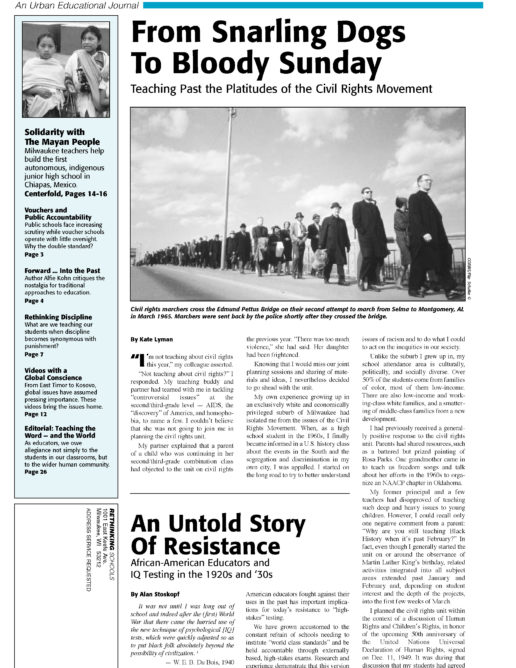Putting Muscle into the Meaning of Solidarity
When I locked my desk, packed up a few boxes, and finished my teaching year last June, little did I know that two months later I would be digging ditches and laying concrete as part of an international group of activists helping to build the first autonomous, indigenous junior high school in Chiapas, Mexico.
I have been a political activist and organizer for almost 30 years and, in more recent years, a high school teacher. My two weeks in Chiapas were, without a doubt, one of the highlights of my political life.
Along with Dennis Oulahan, a bilingual diagnostic teacher from Milwaukee, I traveled to Chiapas as part of an international delegation organized by Schools for Chiapas, a solidarity group based in San Diego, in cooperation with the Zapatista movement. The delegation consisted of about 30 people. About two-thirds were from the United States and were college-age activists, several were from Spain, and about one-third were Mexicans affiliated with the Zapatista movement.
Following a 24-hour bus ride beginning in Mexico City, we arrived in a Zapatista-controlled community in Chiapas called Aguascalientes II Oventic. In the final leg of our journey, a two-hour ride north from the centuries-old city of San Cristóbal de las Casas, we were stopped at three military checkpoints. The soldiers claimed they were searching for guns. There are an estimated 80,000 federal troops stationed in Chiapas, and military helicopters and planes routinely fly over Oventic.
Oventic is one of five “autonomous municipalities” run by the Zapatistas. An unarmed zone, it is a rural compound that includes seven dirt-floor dorms, a community store, a health clinic, an assembly hall, a kitchen, a church, an outdoor stage and arena area, a full-size basketball court (the Mayan sport of preference), storage buildings, a complex of classrooms, a cafeteria, animal grazing areas, and stock pens for rabbits and chickens. The area is surrounded by cornfields tended by Mayan farmers.
WE GET TO WORK
We spent our first week doing repairs – fixing showers, replacing rotted wood boards, painting revolutionary murals, and doing groundwork for the foundation to the new school library that we would be building. The second week, construction began. For three days we dug ditches, each morning bailing out the ditch because of torrential rainstorms during the night. It was during this phase that the Zapatista construction team arrived, consisting of about 50 young men from surrounding communities. The last two days, we laid the cement for the foundation and began putting in the metal-rod bracing for the library’s cement walls.
The junior high school in Oventic will be a boarding school, which is logical in Mexico given the distances that villagers must travel to school. An estimated 250 students and staff will ultimately live at the school. The Zapatistas have a wonderful flair for symbolism, and the new school is scheduled to open January 1, in the new millennium. (A “Y2K Zapatista” caravan is being organized from Dec. 28 to January 5 to take part in celebrating the school’s opening; those interested should contact Schools For Chiapas; see resources page 16.)
While our delegation focused on construction, there was also time for cultural exchange. We often spent late afternoons playing basketball with the Zapatista teachers-in-training at Oventic or with workers from surrounding villages. Evenings were filled up with planning meetings and informal political discussions that often included “peace campers” at Oventic (sponsored by international human rights organizations) and members of the Zapatista movement.
During my two weeks, it was clear that the Zapatistas were not dependent on the delegation’s labor to help build the new school. But the Zapatistas are acutely aware of the importance of international solidarity and education. They are particularly concerned about educating the U.S. public, given that US political and economic interests significantly influence the Mexican government’s policies.
Since I’ve been back, my students, my coworkers, and my friends have all heard about my trip, and have been encouraged to go see for themselves what is happening in Chiapas. I hope, that in my own small way, I am helping others to better understand the struggles of the Mayan people, and the example provided by the Zapatistas for all who are seeking a better world.
![]()
![]()

